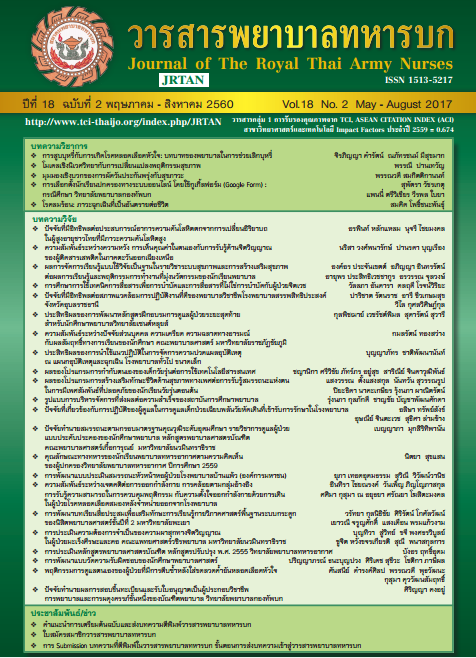พฤติกรรมการดูแลตนเองของผู้ป่วยที่มีการตีบซ้ำ หลังใส่ขดลวดค้ำยันหลอดเลือดหัวใจ
Keywords:
พฤติกรรมการดูแลตนเอง, ข้อมูลทางคลินิก, การตีบซ้ำของหลอดเลือดหัวใจ, self-care behavior, clinical data, in-stent restenosisAbstract
การวิจัยครั้งนี้เป็นการวิจัยเชิงบรรยายมีวัตถุประสงค์เพื่อศึกษาพฤติกรรมการดูแลตนเองข้อมูลทางคลินิกการรับรู้สาเหตุ และแนวทางป้องกันการตีบซ้ำของผู้ป่วยที่เกิดการตีบซ้ำหลังใส่ขดลวดค้ำยันหลอดเลือดหัวใจ กลุ่มตัวอย่าง 22 รายเป็นผู้ป่วยที่มี คุณสมบัติตามที่กำหนด ในเวลา 6 เดือนที่ศึกษา เก็บข้อมูลด้วยการสัมภาษณ์ตามแบบวัดพฤติกรรมการดูแลตนเองที่สร้างจากการ ทบทวนวรรณกรรมและแนวทางทางการปฏิบัติตนเพื่อป้องกันและลดปัจจัยเสี่ยงของโรคหลอดเลือดหัวใจและโรคหลอดเลือดแข็ง ระดับทุติยภูมิวิเคราะห์ข้อมูลด้วยสถิติบรรยาย และการวิเคราะห์เนื้อหา ผลการศึกษาพบว่ากลุ่มตัวอย่างส่วนใหญ่มีหลอดเลือดแดงเลี้ยงหัวใจตีบ 3เส้น ร้อยละ77.3 หลอดเลือดแดงเลี้ยงหัวใจ ด้านขวาและด้านหน้าซ้ายเกิดการตีบซ้ำร้อยละ 45.5 เท่ากันเกิดการตีบซ้ำแบบช้ามาก ร้อยละ 95.5 มีพฤติกรรมการดูแลตนเอง โดยรวมระดับปานกลางมีพฤติกรรมดีด้านการเลิกและไม่อยู่ในที่มีควันบุหรี่และด้านการรับประทานยามีพฤติกรรมปานกลางด้าน การบริโภคอาหาร กิจกรรมทางกาย/การออกกำลังกาย/การพักผ่อน การปฏิบัติตามแผนการรักษา การจัดการความเครียด มี พฤติกรรมไม่ดีด้านจิตสังคมและการแสวงหาความช่วยเหลือมีการรับรู้สาเหตุการตีบซ้ำว่าเกิดจากการปฏิบัติตัวไม่เหมาะสม และ วางแผนป้องกันการตีบซ้ำโดยปรับปรุงพฤติกรรมการบริโภค
Self–Care Behaviors among Patients with Coronary In-stent Restenosis
The purposes of this research is to describe self-care behavior,clinical data, perceived cause of in-stent restenosis and in-stent restenosis prevention plan among patients who have in-stent restenosis. The 22 participants who met the inclusion criteria were enrolledin the study. Data was collected by structured interviewed, and open ended questions based on the guideline for secondary prevention and risk reduction therapy for patients with coronary and other atherosclerotic vascular disease. Clinical data was recorded from the computer based cardiac catheterization report. Data was analyzed by descriptive statistics and content analysis. The resultwas shown that, majority of the participants had triple-vessel disease and the in-stent restenosis were equal between right coronary artery and left anterior descending for 45.5 percent. The self – care behavior average total score was in moderate level. The good self – care behaviors, were the part of smoked cessation and avoid smoke area, and the part of drugs consumption behavior. The average scores which in moderate level were the part of food consumption/nutrition status, physical activities/exercise and rest behavior, treatment adherence/follow treatment plan behavior, and stress/depression management behavior. The part which showed the lowest score was psychosocial support and seeking help behavior. Most of them had perceived cause of in-stent restenosis as their poor self-care behavior and planned to adjust their behavior focused to food consumption.
Downloads
Downloads
How to Cite
Issue
Section
License
บทความหรือข้อคิดเห็นใดใดที่ปรากฏในวารสารพยาบาลทหารบกเป็นวรรณกรรมของผู้เขียน ซึ่งบรรณาธิการหรือสมาคมพยาบาลทหารบก ไม่จำเป็นต้องเห็นด้วย
บทความที่ได้รับการตีพิมพ์เป็นลิขสิทธิ์ของวารสารพยาบาลทหารบก
The ideas and opinions expressed in the Journal of The Royal Thai Army Nurses are those of the authors and not necessarily those
of the editor or Royal Thai Army Nurses Association.






